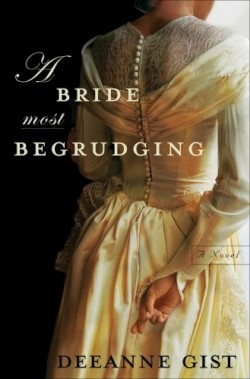A Bride Most Begrudging
It is 1643, and when Lady Constance Morrow bids farewell to her beloved Uncle Skelly—who is chained for transport to the Virginia colony, where he will serve out a sentence placed upon him by the British lords—she is taken by the ship’s captain and carried away to be a “tobacco bride.” The colonists were willing to pay high prices for wives, since few women could survive in the rough wilderness.
All Lady Constance wants is to go home to England. She hopes that when the ship arrives, she can be taken to the Governor of the colony and plead her case before him, accusing the ship’s captain of kidnapping her. Yet, en route, her fine clothes are wrecked by the salt water and filth of the ship, and the only evidence she has to prove her claim of nobility is her diary filled with mathematical problems and riddles, which were published in her uncle’s book, Ladies Mathematical Diary.
Drew O’Connor has only one woman on his mind: a potential maid he’s looking for to care for his young sister Sally. He recently buried a fiancée who was not hardy enough to stay alive in the wilderness of Virginia. When he approaches the captain of the newly docked ship carrying male and female felons who are sentenced to serve in the colony, he also seeks men to build his home and work his fields.
When Lady Constance is released, she finds herself tied, not only in servitude, but also in matrimony to O’Connor, a man she just met, who won her in a game of cards and was forced to wed her.
This tender love story reveals a world not often seen in historical romantic fiction. For example, the author presents the concept of “seasoning,” a glimpse of Colonial history in which people who were new to the colonies were expected to go through a bout of illness that would either “season” them or kill them. Gist presents this concept so seamlessly that the reader is captured in the fictional dream she weaves. Regarding the Ladies Mathematical Diary, Gist uses in her novel many of the puzzles and solutions from the pages of this real 1704 pamphlet, the “first almanac on the market expressly targeting a female audience.” An example of one of these puzzles has the reader guessing the exact time of day from a cane’s length in its own shadow while held in London on the “tenth day of May.” The answer is precise: “Nine hours, thirteen minutes, and sixteen seconds in the morning.”
This exquisite novel is the author’s first, though her teaching background and degree from Texas A&M are evident in the attention to detail that has the reader transported to the rough challenge and glorious beauty of early America.
Reviewed by
Carol Lynn Stewart
Disclosure: This article is not an endorsement, but a review. The publisher of this book provided free copies of the book to have their book reviewed by a professional reviewer. No fee was paid by the publisher for this review. Foreword Reviews only recommends books that we love. Foreword Magazine, Inc. is disclosing this in accordance with the Federal Trade Commission’s 16 CFR, Part 255.

